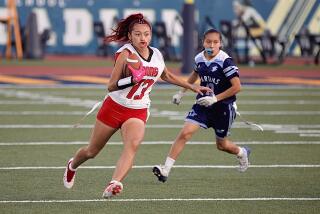Only Anaheim to Have Sobriety Checkpoints
New Year’s Eve is one of the most active periods for drunk drivers, but only one of the county’s 24 police agencies, Anaheim, plans to set up sobriety checkpoints.
Anaheim police have announced that several sobriety checkpoints will be established from 9 p.m. to 3 a.m. on New Year’s Eve. While the specific streets were not announced, police said they will be at locations where there have been numerous accidents and arrests for drunk driving.
Because of the cost in time and manpower to run such checkpoints, however, law enforcement agencies in Costa Mesa, Newport Beach and elsewhere are opting instead to increase patrols to net drunk drivers.
“It takes weeks of planning to get (a checkpoint) set up (and) a total of 30 personnel to run one,” Irvine Police Lt. Robert Lennert explained. “It’s not an inexpensive proposition.”
California Highway Patrol spokesman Ken Daily said that sobriety checkpoints require bringing in officers on overtime because “we don’t want to draw from our regular field personnel to do this. That way, we have the same number of people out working accidents.”
Orange Police Sgt. Timm Browne said the extensive manpower required to operate sobriety checkpoints is “probably our biggest concern. . . . It cuts in on overtime budget and that would probably reflect on our response time during the holiday season,” he said.
But Anaheim police view such checkpoints as a necessary expense to combat the deaths and injuries caused by drunk drivers.
Anaheim Police Sgt. Ronald Lovejoy, who has worked the checkpoints in that city since they were instituted in November, 1984, pointed out: “More people are killed by drunk drivers than by murderers.”
“Fifty percent of fatal (accidents) are alcohol-related,” Lovejoy said. “Recently, we have been running somewhat lower than that. It may or may not be related to the reinstituting of the sobriety checkpoints.”
According to the most recent annual figures compiled by the CHP, in 1987 there were 166 people killed on Orange County streets and freeways in traffic accidents in which alcohol was involved. Another 5,815 people were injured in 3,687 alcohol-related traffic accidents in the county--more than 10 crashes a day.
Statewide, 2,754 were killed and 68,816 injured in alcohol-related accidents, according to the CHP.
Anaheim Police Sgt. Richard Zschoche reduced the issue to elementary terms:
“How much is one life worth if we save one life? The deterrent effect (of sobriety checkpoints) . . . does save lives.”
Sobriety checkpoints began in California in 1984 after a state attorney general’s opinion that outlined procedures. The opinion had been specifically requested by the CHP, and since then, checkpoints have been used off and on, due to legal challenges.
However, after the state Supreme Court gave its approval to the procedure in a Oct. 29, 1987, ruling, sobriety checkpoints have been effective, if infrequently used, tools for many local police departments, authorities said.
Despite cumbersome rules that require advance notification and turn-off points, among others, departments that use checkpoints believe they work.
“In (December) 1986, when everyone knew the sobriety checkpoints had been stopped . . . we had 39 collisions from driving under the influence,” Anaheim Sgt. Zschoche said.
The following December, after the checkpoints were reinstated by the state high court, there were only nine collisions resulting from driving under the influence, he said.
“We attribute that mainly to the publicity of the reinstitution of sobriety checkpoints and the DUI (driving under the influence motorcycle) teams we put out,” he said.
Still, not every police department is convinced of the effectiveness of checkpoints.
“We just don’t use that particular technique,” Newport Beach Police spokesman Greg Armstrong said. “We put out two teams of officers during the evening hours, working 8 p.m. to 4 a.m. . . . each (concentrating on) drunk drivers.”
In Costa Mesa, police will be increasing their two-officer patrols sevenfold to detect drunk drivers on New Year’s Eve, Costa Mesa Police Sgt. John FitzPatrick said.
Normally, he said, one team of two officers patrols the streets. But from 7 tonight to the wee hours Sunday morning, seven teams will be on the lookout for drunk drivers. The city’s police helicopter also will be in action looking for drivers who are speeding, making unsafe lane changes or driving erratically, FitzPatrick said.
To keep the officers free for further patrolling, Costa Mesa police also will have a special team that will go to the scene of each drunk-driving arrest and take the arrestee back to the station for testing and booking, FitzPatrick said.
Costa Mesa police also asked that people with car phones or those who are near a telephone call them if they see anybody driving erratically, as if under the influence of alcohol or other drugs, FitzPatrick said.
Whether departments use checkpoints of beefed-up patrols, the message is the same.
“We think it’s important to call attention to the severity of driving and drinking penalties, and to warn people to take precautions,” FitzPatrick said. “If you’re going to drink, don’t drive. We want to warn people not to do that, and those who don’t heed our warning will pay the penalty.”
Times staff writer Marcida Dodson also contributed to this story.
More to Read
Sign up for Essential California
The most important California stories and recommendations in your inbox every morning.
You may occasionally receive promotional content from the Los Angeles Times.









